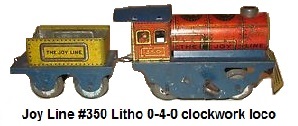 The Girard Model Works of western Pennsylvania, was founded by Frank E. Wood in 1919.
They made various tin toys, banks, toy cash registers, model airplanes, steel autos, trucks, toy boats, roller skates,
and manufactured the early Joy Line trains from 1927 to 1935. Prior to WW1 the German train
manufacturers such as Bing and Bub (KBN) were dominating
sales. After the war, the American consumers wanted American made products, so Girard, along with the
likes of Lionel, American Flyer and
Hafner, was able to successfully provide the American Market with
the toy train products it demanded. In the late 1920's, Girard made Louis Marx a commission agent to sell its products.
Some of the Girard toys bore the slogan "Making Childhood`s Hour Happier."
The Girard Model Works of western Pennsylvania, was founded by Frank E. Wood in 1919.
They made various tin toys, banks, toy cash registers, model airplanes, steel autos, trucks, toy boats, roller skates,
and manufactured the early Joy Line trains from 1927 to 1935. Prior to WW1 the German train
manufacturers such as Bing and Bub (KBN) were dominating
sales. After the war, the American consumers wanted American made products, so Girard, along with the
likes of Lionel, American Flyer and
Hafner, was able to successfully provide the American Market with
the toy train products it demanded. In the late 1920's, Girard made Louis Marx a commission agent to sell its products.
Some of the Girard toys bore the slogan "Making Childhood`s Hour Happier."
Girard Model Works began toy production in 1924 in the Fox building in Albion on East Pearl
Street. Trains were made in this building until 1929, when the operation was moved to the Girard, PA plant.
The early Joy Line trains of the late 1920's were floor trains with crudely flanged wheels. They were
clearly not intended to run on tracks. These items were sold in five and dime stores of that era at ten cents
per unit. The Joy Line items used light tin underframes with light tin couplers. Later on, heavier underframes and couplers, and
flanged wheels were employed for the trains intended for track use. The early loco
for floor use was lithographed in gilt and came with a matching tender. The loco was #350. This loco was powered by a
coil spring made of wire similar to old German floor toys.
 In the 1930's Joy Line put out a series of 4 inch tin lithographed trains intended for track use.
These first products made for track included a short cast iron loco but the switch was eventually made to sheet metal. The
locomotoives were always configured in an 0-4-0 wheel arrangement and painted
red, a combination of red and black, or all black. The tender remained the same in outline, with the differences
that it was no longer lithographed, and that it was made of a heavier metal and had track type flanged wheels. The earliest
of the track type (perhaps all of the cast iron locos) had heavy gauge stamped metal drivers, with no side rods. Four wheeled freight
and passenger cars were part of the line of both windup and electric trains. The trains were whimsical,
colorfully lithographed but affordable. Joy Line trains were very toy-like, not models, with only a passing
resemblance to actual trains.
In the 1930's Joy Line put out a series of 4 inch tin lithographed trains intended for track use.
These first products made for track included a short cast iron loco but the switch was eventually made to sheet metal. The
locomotoives were always configured in an 0-4-0 wheel arrangement and painted
red, a combination of red and black, or all black. The tender remained the same in outline, with the differences
that it was no longer lithographed, and that it was made of a heavier metal and had track type flanged wheels. The earliest
of the track type (perhaps all of the cast iron locos) had heavy gauge stamped metal drivers, with no side rods. Four wheeled freight
and passenger cars were part of the line of both windup and electric trains. The trains were whimsical,
colorfully lithographed but affordable. Joy Line trains were very toy-like, not models, with only a passing
resemblance to actual trains.
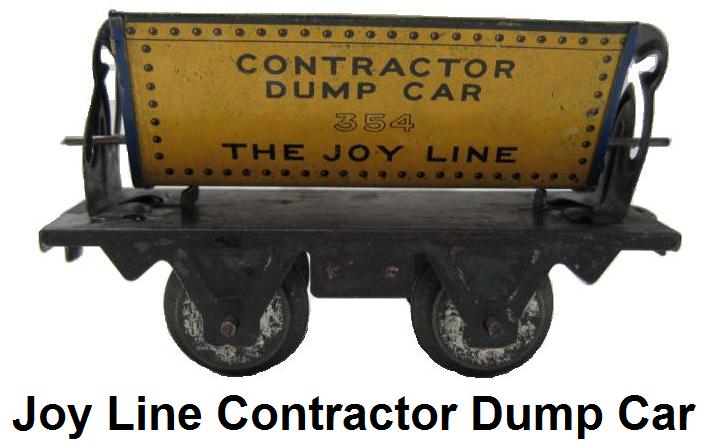 There were 5 basic types of freight cars made. The colorful names used were
the 'Venice Gondola', 'Everful Tank Car', 'Contractor Dump Car', 'Hobo Rest Boxcar' and 'Eagle Eye Caboose'. Each car measured 4½ inches
in length, 2 inches wide and 3 inches high. All were attractively lithographed in 4 or 5 snappy colors. Catalogs stated that they were,
"sturdily constructed and will fit any standard 'O' gauge track."
There were 5 basic types of freight cars made. The colorful names used were
the 'Venice Gondola', 'Everful Tank Car', 'Contractor Dump Car', 'Hobo Rest Boxcar' and 'Eagle Eye Caboose'. Each car measured 4½ inches
in length, 2 inches wide and 3 inches high. All were attractively lithographed in 4 or 5 snappy colors. Catalogs stated that they were,
"sturdily constructed and will fit any standard 'O' gauge track."
The earliest Joy Line engine, #350, was a lithographed tin clockwork that utilized a lightweight coil spring and very
thin tinplate. With tender it measured 10 inches long. It was probably designed originally as a floor toy, as the wheel flanges were poorly
formed and it does not negotiate curved track very well. It was coupled with the adorable #351 Koal Kar tender, and together the two pieces
create an appealing blend of colors and gilt that epitomize what early lithographed train collectors love.
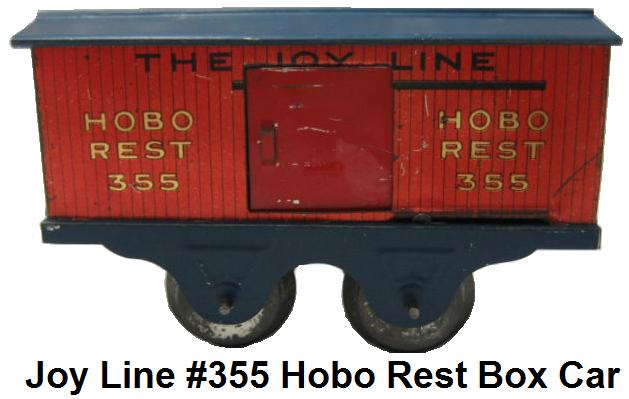 A 1930 Girard catalog shows three basic train set offerings. Set #360 was
called the Joy Line Special and consisted of the #350 engine, #351 Koal Kar tender and #355 Hobo Rest Boxcar. Set #359 titled "Special Train Set"
consisted of just the locomotive and tender. Set #380 was called the Joy Line Extra Cars and was made up of just 4 styles of freight cars -
gondola, tank car, gravel car and caboose. It should be noted that the weak coil-spring clockwork motor in the #350 engine
was not capable of pulling an entire freight set. The sets that included a locomotive were offered together
with four sections of standard 'O' gauge track, making an oval of 60½ inches in circumference. Another set has been observed that
included the #350 engine, #351 Koal Kar tender, and two Yellow Roof coaches.
A 1930 Girard catalog shows three basic train set offerings. Set #360 was
called the Joy Line Special and consisted of the #350 engine, #351 Koal Kar tender and #355 Hobo Rest Boxcar. Set #359 titled "Special Train Set"
consisted of just the locomotive and tender. Set #380 was called the Joy Line Extra Cars and was made up of just 4 styles of freight cars -
gondola, tank car, gravel car and caboose. It should be noted that the weak coil-spring clockwork motor in the #350 engine
was not capable of pulling an entire freight set. The sets that included a locomotive were offered together
with four sections of standard 'O' gauge track, making an oval of 60½ inches in circumference. Another set has been observed that
included the #350 engine, #351 Koal Kar tender, and two Yellow Roof coaches.
Between 1930 and 1933 Girard beefed up Joy Line engines and began offering several variations. First was the cast-iron
engine, which was coupled with the #351 Koal Kar, or an all-black short tender, and was usually offered heading up passenger trains.
For some reason unknown to collectors, the coaches following the cast-iron engine usually had black details and were devoid of the gilt
so prevalent on other Joy Line coaches, both earlier and later. The cast-iron engine was powered by a substantially improved strap-spring
clockwork motor or a forward-only electric motor with headlamp. This was Girardís first electric engine and can be a challenge to locate.
The elusive Powerhouse transformer was sometimes included in sets with the cast-iron electric engine.
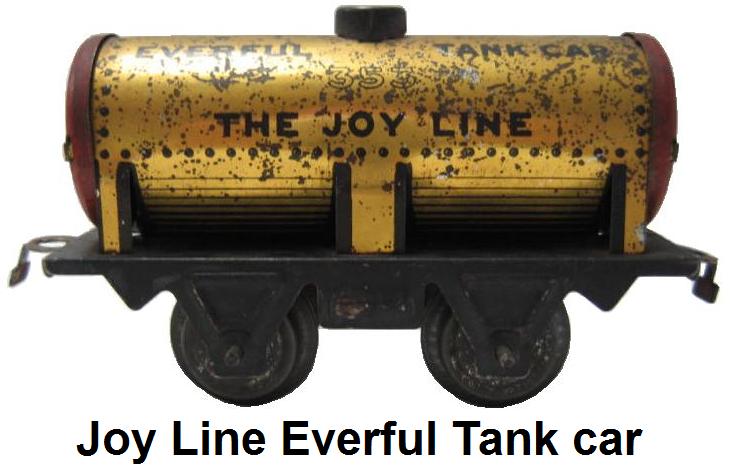 By 1932, Joy Line engines had evolved into heavy pressed-steel locomotives
with a variety of details. Though all were 0-4-0 wheel arrangements, they can be found as clockwork, with or without sparklers,
with or without battery headlamps, painted all red, red over black, or all black. Electric pressed steel engines are black over red and
can be found with forward-only or reversing motors. Some electric engines have hard rubber wheels for increased traction, and there
is also a hard-to-find dummy equipped with a large bell. The earliest electric locos had blued spring steel collectors and stamped metal
drive gears on the drivers. Later came the die-cast wheels with integral drive gears. On one early drive wheel of die-cast the letters
G-I-R-A-R-D appeared between the raised "spoke" detail.
By 1932, Joy Line engines had evolved into heavy pressed-steel locomotives
with a variety of details. Though all were 0-4-0 wheel arrangements, they can be found as clockwork, with or without sparklers,
with or without battery headlamps, painted all red, red over black, or all black. Electric pressed steel engines are black over red and
can be found with forward-only or reversing motors. Some electric engines have hard rubber wheels for increased traction, and there
is also a hard-to-find dummy equipped with a large bell. The earliest electric locos had blued spring steel collectors and stamped metal
drive gears on the drivers. Later came the die-cast wheels with integral drive gears. On one early drive wheel of die-cast the letters
G-I-R-A-R-D appeared between the raised "spoke" detail.
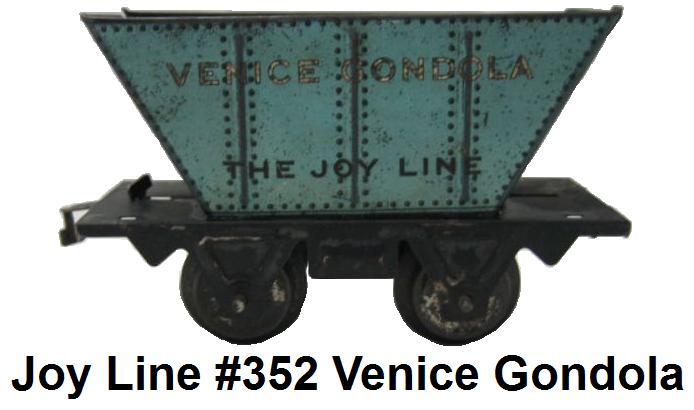 After developing the pressed steel engine, Joy Line offered sets in many varieties, however, there was never any
significant development of either passenger or freight cars. Other than some minor color changes, the only improvement of the rolling
stock was the introduction of heavier steel frames painted black rather than blue, and the heavy steel coupler to replace the flimsy
coupler that had been in use.
After developing the pressed steel engine, Joy Line offered sets in many varieties, however, there was never any
significant development of either passenger or freight cars. Other than some minor color changes, the only improvement of the rolling
stock was the introduction of heavier steel frames painted black rather than blue, and the heavy steel coupler to replace the flimsy
coupler that had been in use.
Post-1930 sets ran the gamut from three-piece clockworks to a
nine-piece double-headed electric passenger set with lighted observation car and an over-under figure-eight track. Typical Joy Line
electric sets are found in corrugated boxes with descriptive-text box art. Larger clockwork sets are usually found in a cardstock
box with beautiful scenic artwork featuring a well-detailed steam train, speedboat, trimotor airplane, and a Graham
automobile, all set against a background that appears to be mid-1930's New York City. It is one of the prettiest toy train boxes sold
by any American manufacturer after World War I (Hoge excepted).
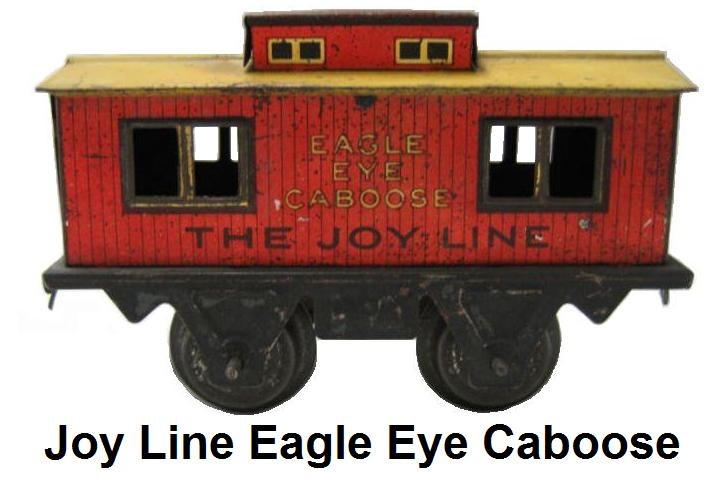 Few Joy Line cars are really hard to find, and only one can truly be considered rare. The early #354 Contractor Dump Car
on blue frame is the least common of the blue-framed freight cars. Among the latter black-framed cars, the Observation with the
lighted drumhead is relatively scarce; and the red #351 short tender is even more elusive. But without doubt, the yellow-roof coach
of the early blue-frame era is truly rare. These cars have a distinct roof design and, as such, cannot be faked
by simple repainting. Furthermore, the yellow roof is lithographed rather than painted, making it virtually impossible to counterfeit.
Of Joy Line engines, the electric cast-iron engine is arguably the most difficult to find, although the pressed-steel dummy engine
is not easily acquired. Normally Joy Line clockworks engines were red over black, and a black over red would have been electric,
but the patient or lucky collector will find the black over red equipped with a clockwork motor.
Few Joy Line cars are really hard to find, and only one can truly be considered rare. The early #354 Contractor Dump Car
on blue frame is the least common of the blue-framed freight cars. Among the latter black-framed cars, the Observation with the
lighted drumhead is relatively scarce; and the red #351 short tender is even more elusive. But without doubt, the yellow-roof coach
of the early blue-frame era is truly rare. These cars have a distinct roof design and, as such, cannot be faked
by simple repainting. Furthermore, the yellow roof is lithographed rather than painted, making it virtually impossible to counterfeit.
Of Joy Line engines, the electric cast-iron engine is arguably the most difficult to find, although the pressed-steel dummy engine
is not easily acquired. Normally Joy Line clockworks engines were red over black, and a black over red would have been electric,
but the patient or lucky collector will find the black over red equipped with a clockwork motor.
Advertisements for Joy Line Trains are difficult to find because the company's philosophy behind the line was
to produce a set of inexpensive trains. The costs of advertising would have had to be recouped, with the result being increased retail costs.
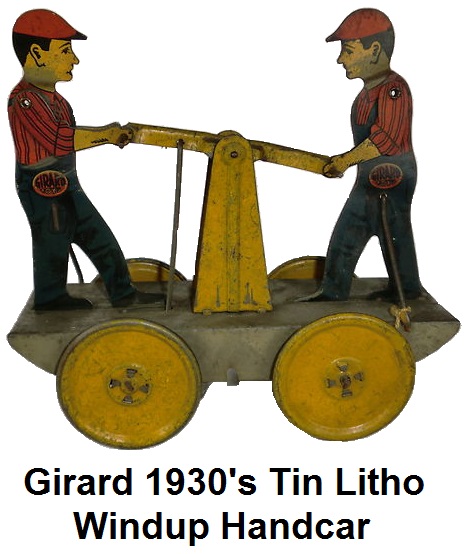 Louis Marx oversaw all Joy Line sales from his offices located in NY
city at 200 Fifth Ave. Marx would later purchase Joy Line after Girard fell
into receivership, a victim of the Great Depression, having declared bankruptcy in 1934. The Girard plant was kept as the primary
manufacturing facility
for Marx branded toy trains and was one of the three major production plants for Marx toys in the USA.
All of the Marx American mainland HO and 'O' scale production would come out of the Girard plant
of Pennsylvania. After Louis Marx purchased Girard he immediately began modernizing the trains offered for sale. Catalogs from 1934
show Joy Line trains for sale alongside the Marx Union Pacific M10000. The Joy Line offerings for that year were large train sets at
reasonable prices, packaged in set boxes with the Marx name. Evidently Marx was dumping the remaining Joy Line inventory.
Louis Marx oversaw all Joy Line sales from his offices located in NY
city at 200 Fifth Ave. Marx would later purchase Joy Line after Girard fell
into receivership, a victim of the Great Depression, having declared bankruptcy in 1934. The Girard plant was kept as the primary
manufacturing facility
for Marx branded toy trains and was one of the three major production plants for Marx toys in the USA.
All of the Marx American mainland HO and 'O' scale production would come out of the Girard plant
of Pennsylvania. After Louis Marx purchased Girard he immediately began modernizing the trains offered for sale. Catalogs from 1934
show Joy Line trains for sale alongside the Marx Union Pacific M10000. The Joy Line offerings for that year were large train sets at
reasonable prices, packaged in set boxes with the Marx name. Evidently Marx was dumping the remaining Joy Line inventory.
At some point the tooling for the Joy Line pressed-steel engine was sent to England, where it was used to head
up British Marx sets. British Joy Line engines have buffers instead of a cowcatcher.
 By 1935, the Joy Line was abandoned by Marx and the well
known Commodore Vanderbilt loco made its entry at the head of a new series of streamlined cars. This was to last
for many years. Joy Line trains were gone from the catalogs of the major
retailers, although they continued to show up for sale here and there as late as 1938 in Marx-labeled boxes. The first year of Marx
train production found Joy Line couplers still in use, and the early Marx M10000 sets had Joy Line motors. For another 40 years,
the Joy Line clockwork motor remained in use with little alteration, powering Marx windup trains.
By 1935, the Joy Line was abandoned by Marx and the well
known Commodore Vanderbilt loco made its entry at the head of a new series of streamlined cars. This was to last
for many years. Joy Line trains were gone from the catalogs of the major
retailers, although they continued to show up for sale here and there as late as 1938 in Marx-labeled boxes. The first year of Marx
train production found Joy Line couplers still in use, and the early Marx M10000 sets had Joy Line motors. For another 40 years,
the Joy Line clockwork motor remained in use with little alteration, powering Marx windup trains.
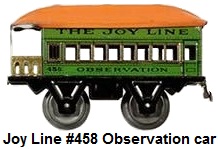 The numbering system used on Joy Line trains was also carried over to Marx train production, with the #351 tender
becoming the #551, the #352 gondola becoming the #552, the #353 tank car converting to #553, and the dump car number #354 being renamed
the #554 hopper. The #355 boxcar became the #555, the #356 caboose became the #556, the #357 coach was now known as the #557, and
the #458 observation became the #558.
The numbering system used on Joy Line trains was also carried over to Marx train production, with the #351 tender
becoming the #551, the #352 gondola becoming the #552, the #353 tank car converting to #553, and the dump car number #354 being renamed
the #554 hopper. The #355 boxcar became the #555, the #356 caboose became the #556, the #357 coach was now known as the #557, and
the #458 observation became the #558.
Little Girard Manufacturing had colored the toy train industry with its motors, numbering system, and its most
energetic and influential salesman, Louis Marx. His marketing strategy would ultimately propel the company he founded, Marx Toys,
to complete domination of the toy market, eventually reaching as far as Japan, Mexico, Great Britain and Germany.

